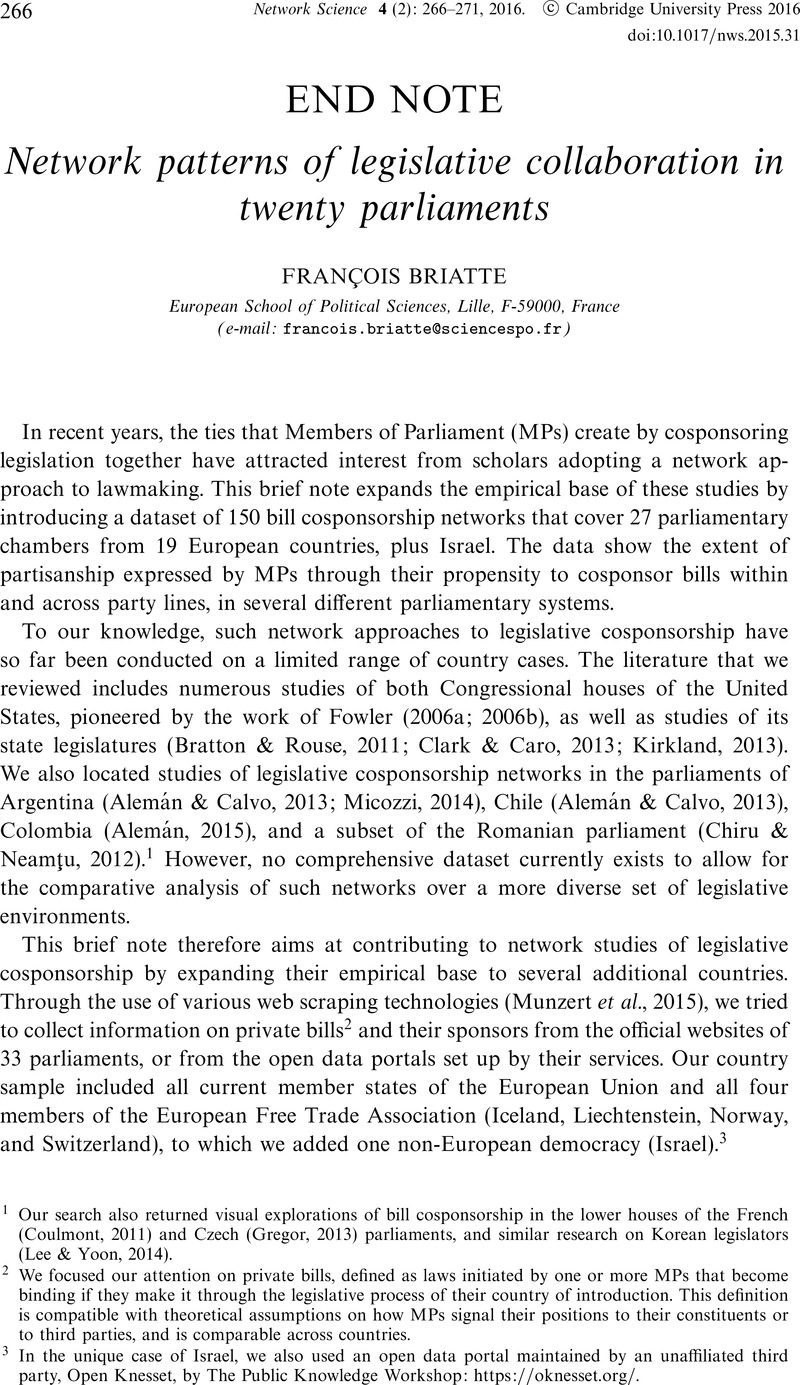Crossref Citations
This article has been cited by the following publications. This list is generated based on data provided by Crossref.
Szoniecky, Samuel
2018.
Challenges of the Internet of Things.
p.
215.
Metz, Florence
Leifeld, Philip
and
Ingold, Karin
2019.
Interdependent policy instrument preferences: a two-mode network approach.
Journal of Public Policy,
Vol. 39,
Issue. 4,
p.
609.
Fischer, Manuel
Varone, Frédéric
Gava, Roy
and
Sciarini, Pascal
2019.
How MPs ties to interest groups matter for legislative co-sponsorship.
Social Networks,
Vol. 57,
Issue. ,
p.
34.
Stewart, Alexander J.
Mosleh, Mohsen
Diakonova, Marina
Arechar, Antonio A.
Rand, David G.
and
Plotkin, Joshua B.
2019.
Information gerrymandering and undemocratic decisions.
Nature,
Vol. 573,
Issue. 7772,
p.
117.
Tian, Yahui
and
Gel, Yulia R.
2019.
Fusing data depth with complex networks: Community detection with prior information.
Computational Statistics & Data Analysis,
Vol. 139,
Issue. ,
p.
99.
HÄGE, FRANK M.
and
RINGE, NILS
2019.
Rapporteur‐shadow rapporteur networks in the European Parliament: The strength of small numbers.
European Journal of Political Research,
Vol. 58,
Issue. 1,
p.
209.
Akirav, Osnat
2020.
Assessing the parliamentary activities of UK MPs.
British Politics,
Vol. 15,
Issue. 2,
p.
201.
Neal, Zachary P.
2020.
A sign of the times? Weak and strong polarization in the U.S. Congress, 1973–2016.
Social Networks,
Vol. 60,
Issue. ,
p.
103.
Solimine, Philip C.
2020.
Political corruption and the congestion of controllability in social networks.
Applied Network Science,
Vol. 5,
Issue. 1,
De Giorgi, Elisabetta
Dias, António
and
Dolný, Branislav
2021.
New Challenger Parties in Opposition: Isolation or Cooperation?.
Parliamentary Affairs,
Vol. 74,
Issue. 3,
p.
662.
Solimine, Philip C.
2021.
Corruption Networks.
p.
29.
Sciarini, Pascal
Fischer, Manuel
Gava, Roy
and
Varone, Frédéric
2021.
The influence of co-sponsorship on MPs’ agenda-setting success.
West European Politics,
Vol. 44,
Issue. 2,
p.
327.
Neal, Zachary P.
2022.
Constructing legislative networks in R using incidentally and backbone.
Connections,
Vol. 42,
Issue. 1,
p.
1.
Nery, Pedro Fernando
and
Mueller, Bernardo
2022.
Co-sponsorship networks in the Brazilian Congress: An exploratory analysis of Caucus influence.
Estudos Econômicos (São Paulo),
Vol. 52,
Issue. 1,
p.
83.
Signorelli, Mirko
and
Cutillo, Luisa
2022.
On community structure validation in real networks.
Computational Statistics,
Vol. 37,
Issue. 3,
p.
1165.
Duxbury, Scott W
2024.
“The Ties that Bind are those that Punish: Network Polarization and Federal Crime Policy Gridlock, 1979–2005”.
Social Forces,
Vol. 103,
Issue. 1,
p.
262.
Duxbury, Scott W.
2024.
Collaborating on the Carceral State: Political Elite Polarization and the Expansion of Federal Crime Legislation Networks, 1979 to 2005.
American Sociological Review,
Vol. 89,
Issue. 4,
p.
650.
Bucher, Jan
2024.
Survival of the social? Effects of intra-party cooperation on MP renomination.
Party Politics,
Vol. 30,
Issue. 1,
p.
37.



